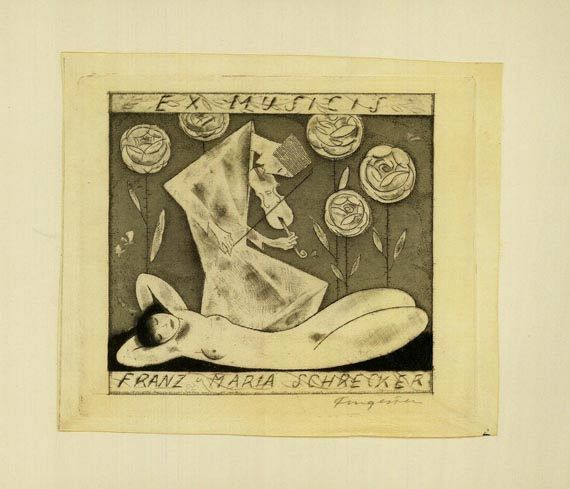Dictionary


Ex libris / Bookplate
The Latin term ex libris means literally "out of the books" and represents a label indicating the owner of a book and in the modern continental European sense, for the bookplate itself on which the owner's name appears. A bookplate is usually on the board paper, the firm outer leaf of an end-paper and is in the form of a miniature print bearing the owner's name(s) or monogram. A bookplate or ex libris is artistically rendered to consist of armorial bearings, ornaments, allegories, symbols, portraits, still lifes, landscapes or illustrations indicating profession, etc. Artists of all periods, including L. Cranach, A. Dürer, H. Holbein, M. Behmer, M. Fingesten, M. Klinger, H. Vogeler-Worpswede, have devoted themselves to creating bookplates, using a wide variety of printing processes and techniques. Several societies (including the Deutsche-Exlibris-Gesellschaft in Germany) are dedicated to the cultivation, promotion and scholarship of ex libris as an art.
The Latin term ex libris means literally "out of the books" and represents a label indicating the owner of a book and in the modern continental European sense, for the bookplate itself on which the owner's name appears. A bookplate is usually on the board paper, the firm outer leaf of an end-paper and is in the form of a miniature print bearing the owner's name(s) or monogram. A bookplate or ex libris is artistically rendered to consist of armorial bearings, ornaments, allegories, symbols, portraits, still lifes, landscapes or illustrations indicating profession, etc. Artists of all periods, including L. Cranach, A. Dürer, H. Holbein, M. Behmer, M. Fingesten, M. Klinger, H. Vogeler-Worpswede, have devoted themselves to creating bookplates, using a wide variety of printing processes and techniques. Several societies (including the Deutsche-Exlibris-Gesellschaft in Germany) are dedicated to the cultivation, promotion and scholarship of ex libris as an art.
Offers
Headquarters
Joseph-Wild-Str. 18
81829 Munich
Phone: +49 89 55 244-0
Fax: +49 89 55 244-177
info@kettererkunst.de
Louisa von Saucken / Undine Schleifer
Holstenwall 5
20355 Hamburg
Phone: +49 40 37 49 61-0
Fax: +49 40 37 49 61-66
infohamburg@kettererkunst.de
Dr. Simone Wiechers / Nane Schlage
Fasanenstr. 70
10719 Berlin
Phone: +49 30 88 67 53-63
Fax: +49 30 88 67 56-43
infoberlin@kettererkunst.de
Cordula Lichtenberg
Gertrudenstraße 24-28
50667 Cologne
Phone: +49 221 510 908-15
infokoeln@kettererkunst.de
Hessen
Rhineland-Palatinate
Miriam Heß
Phone: +49 62 21 58 80-038
Fax: +49 62 21 58 80-595
infoheidelberg@kettererkunst.de
We will inform you in time.




